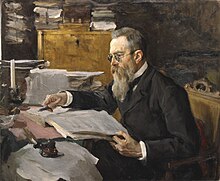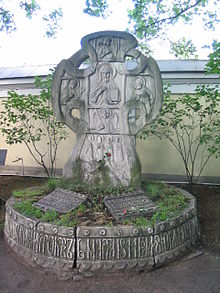Nikolai Andreevich Rimsky-Korsakov

Nikolai Rimsky-Korsakov ( Russian Николай Андреевич Римский-Корсаков ., Scientific transliteration Nikolai Rimsky-Korsakov Andreevič , born March 6 . Jul / 18th March 1844 greg. In Tikhvin , province Novgorod ; † June 8 jul. / 21st June 1908 greg. On Gut Ljubensk near Luga , governorate Saint Petersburg ) was a Russian composer .
Life
Rimsky-Korsakov came from the respected Rimsky-Korsakov family, whose male members were traditionally in military service, especially in the Russian Navy. The parents were also very interested in music, recognized his musical talent and encouraged it.
In 1856 began his military and school training in the Naval Cadet Corps in Saint Petersburg, which he completed in 1862.
Rimsky-Korsakov continued his piano lessons at the cadet school, but was mainly interested in opera and the instruments used in it. As a 13-year-old he wrote the following letter to his uncle:
“Dearest uncle! Imagine my joy, today I'm going to the theater! I will see Lucia ! I will hear the huge orchestra and tam-tam! and see how the conductor waves his little stick around! The orchestra has 12 violins, 8 violas, 6 cellos, 6 double basses, 3 flutes, 8 clarinets, 6 horns and all that stuff. "
In the fall of 1859 he received a new piano teacher, Théodore Camille , who introduced him to the composers Balakirew and Cui . Encouraged by his sponsors, he began to write his first work, a symphony in E flat minor. However, he was only able to complete the work in 1865, since after completing his training he was initially in command of the warship "Almas" for three years. At the end of 1865 Balakirev finally performed the work in Petersburg. In the following years Rimsky-Korsakov became increasingly concerned with Russian folk music and Old Russian traditions. When he set the fantastic play Snegurotschka ("Snow Maiden") by the Russian playwright Alexander Nikolajewitsch Ostrowski as an opera in 1880 , he spent this time in a state of extraordinary excitement, as he later described:
“Praying to nature - to a crooked old tree stump, to a willow or centuries-old oak, to the forest stream, to the lake ... or to the cockcrow that scares away the witchcraft of the night ... It sometimes seemed to me that animals, birds, even trees and flowers know more about magic and fantasy than humans ... I believed in all of this with warmth like a child ... and in those minutes the world seemed closer, more understandable, and I was somehow merged with it! "
In July 1871 he became professor of instrumentation and composition at the St. Petersburg Conservatory , and on June 30th jul. / July 12, 1872 greg. he married Nadeschda Nikolajewna Purgold , also a composer and excellent pianist. From 1874 to 1881 he was director of the free school for music and worked as a conductor and teacher. Due to his significant academic position and his great popularity, he was probably the most influential representative of the so-called "Mighty Heap" . He also played an important role in the processing and dissemination of Mussorgsky's works , which he sought to make available to the public in an often smoothed out form. His compositional style was influenced by Glinka and Balakirew, Berlioz and Liszt . His immediate students included Glazunov , Grechaninov , Stravinsky , Witold Maliszewski and Prokofiev ; his influence can also be felt in the orchestral works of Ravel , Debussy , Dukas and Ottorino Respighi .
In the summer of 1908, Nikolai Andrejewitsch Rimsky-Korsakow died of a heart attack in his country house . The violinist Natasha Korsakova is a descendant of Rimsky-Korsakov.
music
Rimski-Korsakow created 15 operas, various orchestral works, most of which are included in program music, but also choral works, chamber works, piano music for two and four hands, songs, transcriptions and orchestrations.
His operas can be roughly divided into historical operas and those with fantastic elements, some of which are explicitly referred to as fairy tales in the title ( The Tale of Tsar Saltan ) or in the generic name ( Snegurotschka , Kashchei the Immortal ). He used two types of musical language: on the one hand diatonic and lyrical, in a few cases with quotations from Russian folk music, for the human characters - on the other hand, chromatic and highly artificial, often based on a whole-tone scale , for the magical figures.
Operas
- Pskowitjanka ( The Girl from Pskov ) based on a drama by Lev Alexandrowitsch Mei (1868–72, UA 1873)
- Bojarynja Wera Scheloga ( The Boyarin Wera Scheloga, 1877–78, WP 1898)
- Maiskaja notsch ( The May Night, 1878–79, WP 1880)
- Snegurochka ( Snow Maiden, 1880–81, UA 1882)
- Mlada (1889–90, UA 1892)
- Notsch pered Roshdestwom ( The Night Before Christmas, 1894–95, UA 1895)
- Sadko (1895–96, UA 1898)
- Mozart i Saljeri ( Mozart and Salieri, 1897, WP 1898)
- Tsarskaja newesta ( The Tsar's Bride ), based on a drama by Lev Alexandrovich Mei (1898, UA 1899)
- Skaska o zare Saltane ( The fairy tale of Tsar Saltan, 1899–1900, UA 1900 - contains his most famous work: The Flight of the Bumblebee )
- Servilia , based on a drama by Lev Alexandrowitsch Mei (1900–01, WP 1902)
- Kashchei bessmertny ( Kashchei the Immortal, 1901-02, WP 1902)
- Pan Wojewoda ( Pan Wojewode, 1902–03, UA 1904)
- Skasanije o newidimom grade Kitesche i dewe Fewronii ( The legend of the invisible city of Kitesch and of the virgin Fewronija, 1903-04, UA 1907)
- Solotoi petuschok ( The Golden Rooster, 1906-07, WP 1909)
Symphonies
- Symphony No. 1 in E flat minor, Op. 1 (1861–65 / 1884)
- Symphony No. 2 op.9 Antar Symphonic Suite (1868/1875/1897)
- Symphony No. 3 in A minor + C major (1866–73 / 1886/1899 / 1904–1906)
Further orchestral works
- Overture on Russian Themes, Op. 28 (1866 / 1879–80)
- Fantasy on Serbian Themes, Op. 6 (1867 / 1886–87)
- Sadko op.5 (1867/1869/1892)
- Orchestration of 2 movements from the piano cycle Pictures at an Exhibition by Modest Mussorgsky (1874)
- Concerto in B flat major for trombone and wind orchestra (Allegro vivace - Andante cantabile - Allegro) (1877–1878)
- Concert piece in E flat major for clarinet and wind orchestra (Allegro moderato - Andante - Allegro moderato) (1878)
- Variations in G minor for oboe and wind orchestra on a theme by Michail Glinka Chto krasotka molodaya (theme, 12 variations and finale) (1878)
- Skaska (fairy tales) op. 29 (1879–1880)
- Sinfonietta on Russian Themes in A minor, Op. 31 (1880–1884)
- Piano Concerto in C sharp minor, op. 30 (1882–1883)
- Fantasy on two Russian themes for violin and orchestra op.33 (1886–1887)
- Kapritschtschio na ispanskije temi (Capriccio espagnol) op.34 (1887)
- Scheherazade . Symphonic Suite op.35 (1888)
- Swetly prasdnik (Russian Easter) . Overture op.36 (1888)
- Serenade for violoncello and orchestra op.37 (1903)
- Nad mogiloi (At the grave) op.61 (1904)
- Dubinuschka op.62 (1905)
Chamber music
- String Quartet in F major op.12 (1875)
- String Sextet in A major (1876)
- Quintet in B flat major for flute, clarinet, horn, bassoon and piano (1876)
- String quartet on Russian themes (1878–79; 1st – 3rd movements arranged for Sinfonietta op. 31)
- String Quartet in G major (1897)
- Piano Trio in C minor (1897)

Music theory work
- Harmony
Fonts
- Chronicle of my musical life. Reclam, Leipzig 1968.
literature
- Dorothea Redepennig: Rimskij-Korsakow, Nicolaj. In: Ludwig Finscher (Hrsg.): The music in past and present . Second edition, personal section, volume 14 (Riccati - Schönstein). Bärenreiter / Metzler, Kassel et al. 2005, ISBN 3-7618-1134-9 , Sp. 138–165 ( online edition , subscription required for full access)
- Sigrid Neef : The Russian Five: Balakirew - Borodin - Cui - Mussorgsky - Rimsky-Korsakov. Monographs - documents - letters - programs - works . Ernst Kuhn publishing house. Berlin 1992, ISBN 3-928864-04-1 .
- Ernst Kuhn (ed.): Nikolai Rimsky-Korsakow, access to life and work. Monographs - publications - diaries - directories. With a “directory of the musical works of Nikolai Rimsky-Korsakov”, a “systematic selection bibliography of international literature on the life and work of Nikolai Rimsky-Korsakov up to 1998” and a directory of his students. Kuhn, Berlin 2000, ISBN 3-928864-15-7 .
- Nikolai van der Pals : NA Rimsky-Korssakow. Inaugural dissertation . Breitkopf & Härtel, Leipzig 1914. (W. Bessel, Leipzig 1929, G. Olms, Hildesheim 1977 (Repr), ISBN 3-487-06427-8 )
- Nikolai Rimsky-Korsakov: Principles of Orchestration. Dover Publications, London 1964, ISBN 0-486-21266-1 . (English) ( online as PDFs, German)
- Nikolai Rimsky-Korssakow: Basics of orchestration. Berlin et al. 1922.
- Gesine Schröder : Refined ... or would you prefer raw? : on the effect of Rimsky-Korsakov's orchestration theory in Germany.
Web links
- Works by and about Nikolai Andrejewitsch Rimski-Korsakow in the catalog of the German National Library
- Works by and about Nikolai Andrejewitsch Rimski-Korsakow in the German Digital Library
- Russian music archive
- Principles of Orchestration, an online interactive textbook
- Piano sheet music from the flight of the bumblebee as pdf free
- Sheet music and audio files by Rimsky-Korsakov in the International Music Score Library Project
- Stefan Zednik: Born 175 years ago - the Russian composer Nikolai Andrejewitsch Rimski-Korsakow. Report from March 18, 2019 on Deutschlandfunk
Individual evidence
- ↑ Marina Lobanova: Rimskaja-Korsakowa, Nadeshda. (PDF) In: MUGi Music and Gender on the Internet. Hamburg University of Music and Theater , July 29, 2011, accessed on January 31, 2016 .
- ↑ Götz Heinrich Loos: Korsakowa simply breathtaking. In: Westfälische Rundschau. October 16, 2008, accessed October 2, 2018 .
| personal data | |
|---|---|
| SURNAME | Rimsky-Korsakov, Nikolai Andrejewitsch |
| ALTERNATIVE NAMES | Rimsky-Korsakov, Nikolaj A .; Rimsky-Korsakov, Nikolaj Andreevic; Ри́мский-Ко́рсаков, Никола́й Андре́евич (Russian) |
| SHORT DESCRIPTION | Russian composer |
| DATE OF BIRTH | March 18, 1844 |
| PLACE OF BIRTH | Tikhvin , Novgorod Governorate |
| DATE OF DEATH | June 21, 1908 |
| Place of death | at Lyubensk Manor near Luga , Saint Petersburg Governorate |

